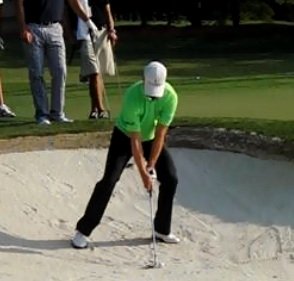The Correct Wedge Bounce
Why is wedge bounce important? It is for several reasons. You need to make sure your wedges bounce are fit for variety of lies.
In addition to putting, having the correct bounce on a wedge is another vital factor to you being successful within a 100 yards. To determine what is a correct golf wedge bounce it may be helpful first to understand what it is.
According to Vokey.com, "bounce is the angle created between the sole line of the golf club (the line from the leading edge to the trailing edge) and the ground line at address."
Here's a picture that will demonstrate:
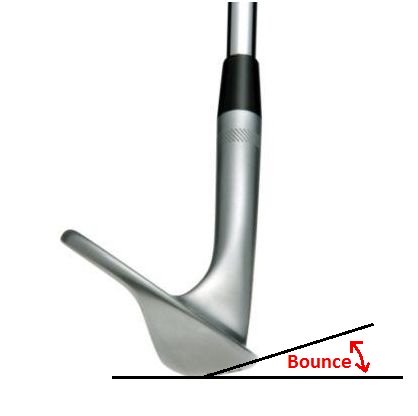
In order to measure the bounce you will need to do the following:
- Measure your wedge's face angle, usually it is stated on the club head
- Measure the face angle to sole angle with a protractor
- Add these two measurements together
- Subtract 90 using the previous total and you will get the bounce angle
Here's a picture that will help:
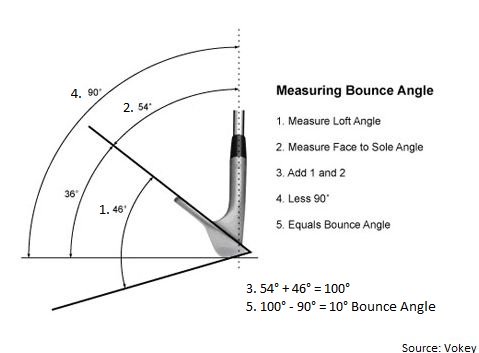
When you have determined the bounce on the wedge the next step is to understand what bounce is required from certain lies.
For example, when playing from a thin lie such as tightly mowed fairway, fringe, or shallow sand it is best to use a wedge with a lower bounce. If you use a higher bounce then you will be exposing the leading edge off the ground and increasing the chance to hit the shot thin.
The picture below is of a PGA Tour player playing pitch shot from a tight lie.
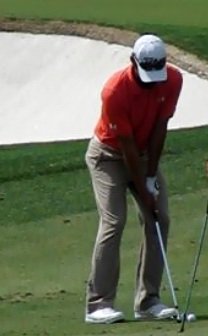
As for lies such as thick rough, soft sand, or lies with space under the ball it will be best to use a wedge with a higher bounce. The following picture is of Zach Johnson before he blasts a ball out of soft sand.
It is important to have a variety of wedges with different bounces if you're a serious golfer. A good number would be to use 3 wedges such as a pitching wedge, sand wedge, and lob wedge. By using three wedges you ensure that the pitching wedge has the highest bounce, the sand wedge with medium bounce, and then the lob wedge with the least amount of bounce.
Having the correct wedge bounce can mean the difference in a thin shot or a fat shot. I hope you make the right decision and investigate are your wedge's bounce fit?
Follow Us on Facebook and Twitter
We appreciate anything you can contribute to this website. We appreciate your support as we do not take your donations lightly as it helps keep our website current and fresh with information. To donate please use the button below. If you give $20 or more we will send you our free E-Book "The Major Swing Philosophies of Golf" by Bo Watson
Subscribe to our Monthly Newsletter!
 Can't find what you're looking for? Ask me over at Golf Questions and Answers Page.
Can't find what you're looking for? Ask me over at Golf Questions and Answers Page.
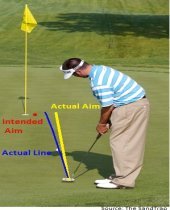 Find out why a correctly fit putter is crucial to the success of your Putting Line.
Find out why a correctly fit putter is crucial to the success of your Putting Line.
Testimonials:
Bo, I wanted to thank you for your help so far with my golf game. I wanted to let you know that I shot a 75 the other day in a tournament round, my best round ever. I had 32 total putts and NO 3 putts. I definitely couldn't have done that before. Thanks again and I'll be back in touch soon to get some more lessons lined up.
Brett
Bo I just wanted to tell you about another tournament I played in. I went out and played and shot a 75 which is one of my best rounds this year so I think everything is coming together. I've been making alot of birdies lately and just wanted to thank you for everything!
Adam Mikhalko
Hey Bo when I got back from camp I played really well I’m putting great and I’m hitting the ball well. Thank you for everything at camp.
Alvaro
Hey Bo!!! I have been playing my best in golf, mostly because of you!!! two days ago I shot an 80 in my club tourney and came in 3rd place.
Brandtley Taylor
I played in a tournament when I got back from camp and shot 76 and came in fourth. I feel much more confident on the course with my mental thoughts. I used the tips you wrote down on that sheet and they have helped me alot.
Freddy Weber
